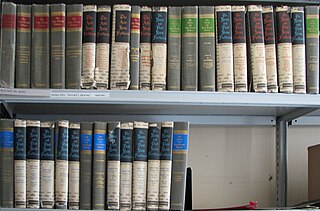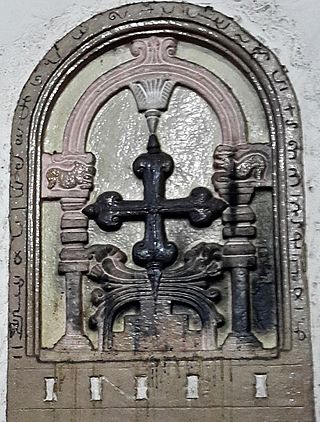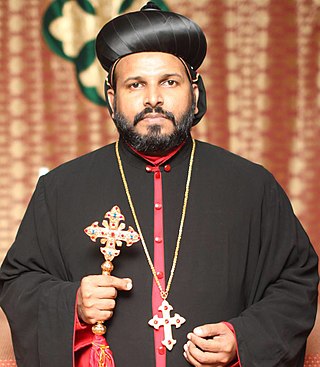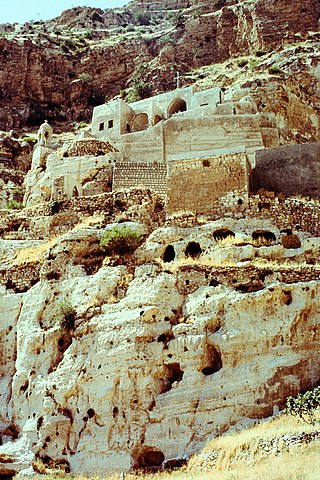
The Malankara Orthodox Syrian Church (MOSC) also known as the Indian Orthodox Church (IOC) or simply as the Malankara Church, is an autocephalous Oriental Orthodox church headquartered in Devalokam, near Kottayam, India. It serves India's Saint Thomas Christian population. According to tradition, these communities originated in the missions of Thomas the Apostle in the 1st century. It employs the Malankara Rite, an Indian form of the West Syriac liturgical rite.

The Greek Orthodox Patriarchate of Antioch, also known as the Antiochian Orthodox Church and legally as the RūmOrthodox Patriarchate of Antioch and All the East, is an autocephalous Greek Orthodox church within the wider communion of Eastern Orthodox Christianity that originates from the historical Church of Antioch. Headed by the Greek Orthodox patriarch of Antioch, it considers itself the successor to the Christian community founded in Antioch by the Apostles Peter and Paul. It is one of the largest Christian denominations of the Middle East, alongside the Copts of Egypt and the Maronites of Lebanon.
The Xi'an Stele or the Jingjiao Stele, sometimes translated as the "Nestorian Stele," is a Tang Chinese stele erected in 781 that documents 150 years of early Christianity in China. It is a limestone block 279 centimetres high with text in both Chinese and Syriac describing the existence of Christian communities in several cities in northern China. It reveals that the initial Church of the East had met recognition by the Tang Emperor Taizong, due to efforts of the Christian missionary Alopen in 635. According to the stele, Alopen and his fellow Syriac missionaries came to China from Daqin in the ninth year of Emperor Taizong (635), bringing sacred books and images. The Church of the East monk Adam composed the text on the stele. Buried in 845, probably during the Huichang persecution of Buddhism, the stele was not rediscovered until 1625. It is now in the Stele Forest in Xi'an.

Syriac Christianity is a branch of Eastern Christianity of which formative theological writings and traditional liturgies are expressed in the Classical Syriac language, a variation of the old Aramaic language. In a wider sense, the term can also refer to Aramaic Christianity in general, thus encompassing all Christian traditions that are based on liturgical uses of the Aramaic language and its variations, both historical and modern.

The Church of the East was a Christian organization with a presence in China during two periods: first from the 7th through the 10th century in the Tang dynasty, when it was known as Jingjiao, and later during the Yuan dynasty in the 13th and 14th centuries, when it was described alongside other foreign religions like Catholicism and possibly Manichaeism as Yelikewen jiao.

Patristics or patrology is the study of the early Christian writers who are designated Church Fathers. The names derive from the combined forms of Latin pater and Greek πᾰτήρ (father). The period of the Church Fathers, commonly called the Patristic era, is generally considered to run from the end of New Testament times or end of the Apostolic Age to either AD 451 or to the Second Council of Nicaea in 787.

Terms for Syriac Christians are endonymic (native) and exonymic (foreign) terms, that are used as designations for Syriac Christians, as adherents of Syriac Christianity. In its widest scope, Syriac Christianity encompass all Christian denominations that follow East Syriac Rite or West Syriac Rite, and thus use Classical Syriac as their main liturgical language. Traditional divisions among Syriac Christians along denominational lines are reflected in the use of various theological and ecclesiological designations, both historical and modern. Specific terms such as: Jacobites, Saint Thomas Syrian Christians, Maronites, Melkites, Nasranis, and Nestorians have been used in reference to distinctive groups and branches of Eastern Christianity, including those of Syriac liturgical and linguistic traditions. Some of those terms are polysemic, and their uses have been a subject of terminological disputes between different communities, and also among scholars.

Christianity is the third-largest practiced religion in Kerala, accounting for 18% of the population according to the 2001 Indian census. According to traditional accounts, Thomas the Apostle sailed to the Malabar region in 52 AD and introduced Christianity to the area. Although a minority, the Christian population of Kerala is proportionally much larger than that of India as a whole. A significant portion of the Indian Christian population resides in the state.

The Council of Seleucia-Ctesiphon, also called the Council of Mar Isaac, met in AD 410 in Seleucia-Ctesiphon, the capital of the Persian Sassanid Empire. Convoked by King Yazdegerd I (399–421), it organized the Christians of his empire into a single structured Church, which became known as the Church of the East. It is often compared to Constantine's Edict of Milan, approximately a century earlier. The events of this council are documented in the Synodicon Orientale.

The Oriental Orthodox Churches are Eastern Christian churches adhering to Miaphysite Christology, with approximately 50 million members worldwide. The Oriental Orthodox Churches adhere to the Nicene Christian tradition. Oriental Orthodoxy is one of the oldest branches in Christianity.

Adam, also known by his Chinese name Jingjing, was an 8th-century Syriac Christian monk and scholar in China. He composed the text on the Nestorian Stele, which described the history of the Church of the East in China from 635 to 781. Many scholars believe he is also the author of the later Jingjiao Documents.

The Church of the East or the East Syriac Church, also called the Church of Seleucia-Ctesiphon, the Persian Church, the Assyrian Church, the Babylonian Church or the Nestorian Church, is one of three major branches of Nicene Eastern Christianity that arose from the Christological controversies in the 5th century and the 6th century, alongside that of Miaphysitism and the Chalcedonian Church.
Mar Shimun XVI Yohannan was Patriarch of the Shem'on line (Qodshanis) of the Church of the East, from 1780. In 1804, he became the sole Patriarch among traditionalist Christians of the East Syriac Rite, because the rival Patriarch Eliya XII (1778-1804) of the Eliya line died without successor. Shimun XVI remained patriarch until his death in 1820.

Eastern Orthodoxy in Syria represents Christians in Syria who are adherents of the Eastern Orthodox Church. The Eastern Orthodox tradition is represented in Syria by the Greek Orthodox Church of Antioch, the largest and oldest Christian community in the country.

Mor Anthimos Mathews is a Syriac Orthodox bishop, currently Metropolitan of Muvattupuzha Region and Patriarchal Vicar of U.K. & Ireland Dioceses.
Baby Varghese, born in India, is a Malankara Orthodox priest and a Church historian and scholar in Syriac Liturgical Theology.

Eliya XI was Patriarch of the Church of the East from 1722 to 1778, with his residence in Rabban Hormizd Monastery, near Alqosh, in modern Iraq. His father, the priest Hoshaba, was the brother of the previous patriarch Eliya X. Upon that patriarch's death, Eliya XI was elected to the patriarchal see, and enthroned on 25 December 1722.
David was a monk, bishop and historian of the Church of the East in the 7th or 8th century.

The Nestorian pillar of Luoyang is a Tang Chinese pillar erected in 814–815 CE, which contains inscriptions related to early Christianity in China, particularly the Church of the East. It is a Nestorian pillar, discovered in 2006 in Luoyang, which is related to the Xi'an Stele.
George was the king of the Ongud and an official of the Yuan dynasty in the late 13th century.














